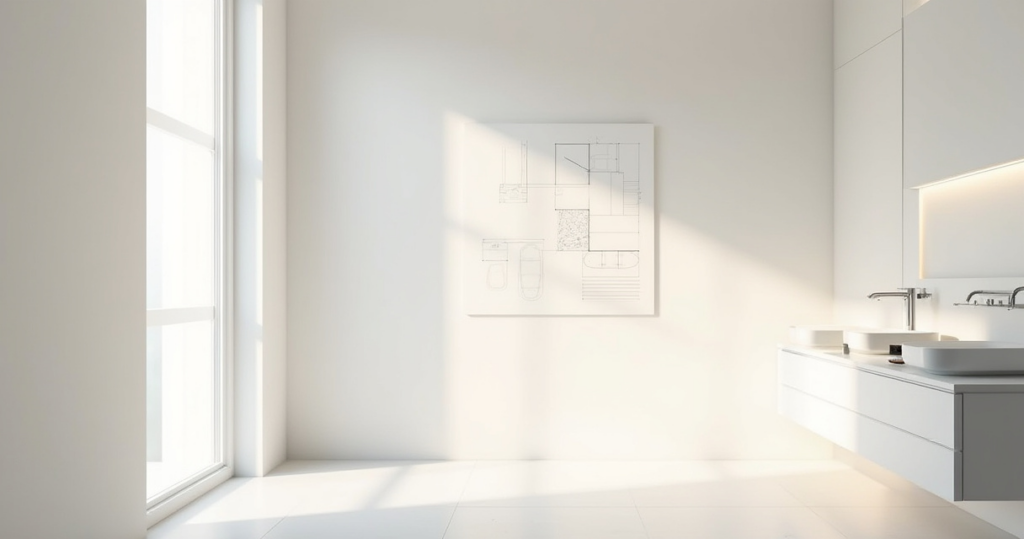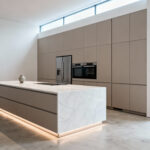I’ve noticed something strange about modern renovations lately. Everyone is drowning in choices—endless feeds of perfect bathrooms, a thousand shades of white, faucets that cost more than a small car. They chase a picture, but they forget to ask the most important question: “How do I want to feel in this space?”
A bathroom is not just a room for function. In Japan, the bath is a place for ritual, for purification, for letting go of the day. It is a transition. Most modern renovations miss this completely. They fill the space with noise—more tile, more gadgets, more stuff. They forget that true luxury is not about what you add, but what you can thoughtfully leave out. It’s about the quiet space, the ma.
So, you asked me about this. Let me share with you what truly matters. This is not a checklist to complete, but a series of contemplations to guide you. Forget the noise. Let’s create a space that calms your soul.
Laying the Groundwork: Essential Planning for Your Modern Oasis (Part 1)
Before a single hammer is lifted, the most important work is done in silence. This is the stage of intention. Rushing this part is like trying to paint a masterpiece on a crumbling wall. We must first prepare the canvas and clear our minds.
1. Defining Your Modern Aesthetic & Functionality Goals
People always ask me to help them pick a “style.” I tell them to forget style for a moment. Instead, close your eyes and imagine the first morning you will use your new bathroom. What do you feel? Is it the quiet warmth of stone under your feet? The clean, open air? The simple joy of a single, beautiful fixture that works perfectly in your hand? Your goal is not a “minimalist” or “industrial” bathroom. Your goal is a feeling.
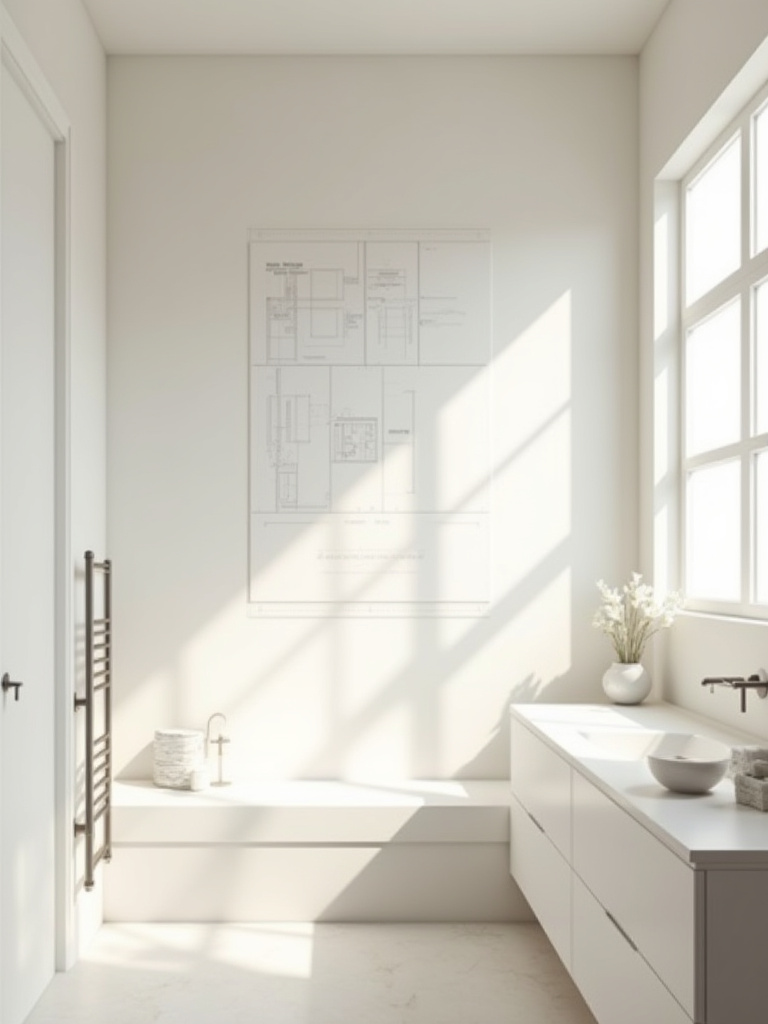
Once you have this feeling—calm, energized, grounded—then we can talk about function. The function must serve the feeling. A feeling of calm requires a lack of clutter, which means we must design beautiful, hidden storage. A feeling of energy might come from invigorating light and a powerful shower. Write down the feeling first, and then list the functions that will help you achieve it. This is the only “mood board” that truly matters.
Once you have this clarity of feeling, you will find the endless product choices become quiet, and the right path forward becomes clear.
2. Establishing a Realistic Budget & Contingency Fund
Everyone sees the budget as a restriction. A barrier to their vision. This is the wrong way to look at it. A budget is a tool for focus. It is a container that forces us to make intentional choices. It asks us, “What is truly essential for the feeling we want to create?” Often, the most beautiful solutions arise not from unlimited funds, but from thoughtful constraints.
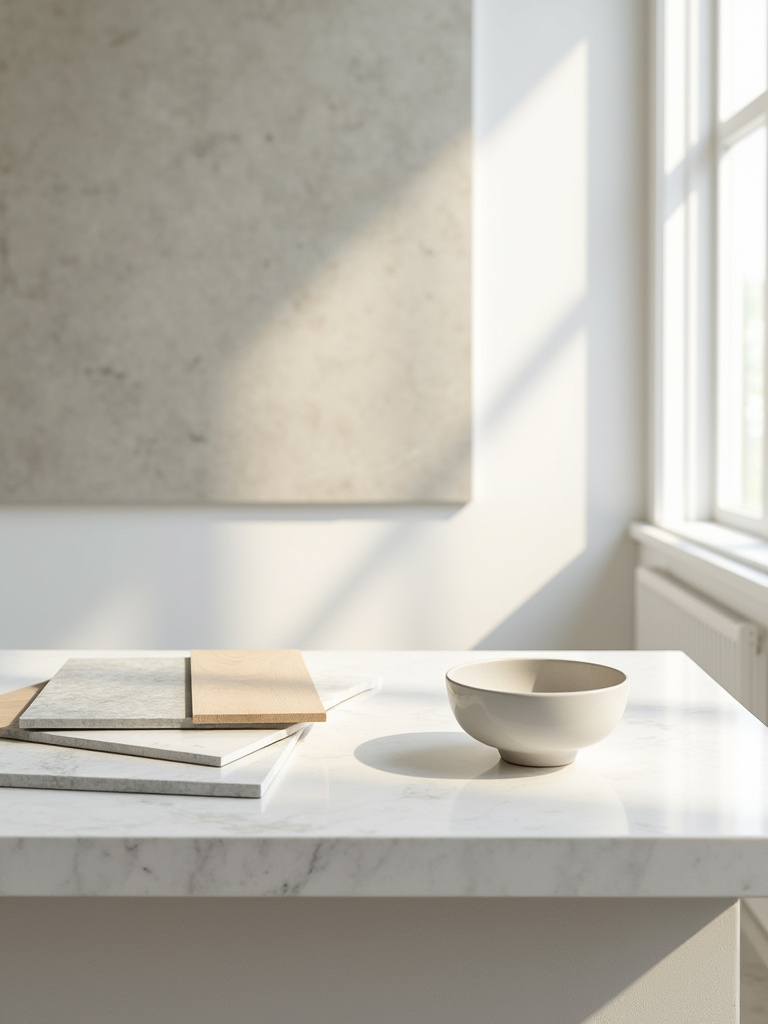
You must also honor the unknown. Set aside 15% that you do not touch. This is your contingency. It is a mark of respect for the unexpected things a house can reveal. Finding old, damaged pipes is not a disaster; it is simply the house speaking to you. Having this fund allows you to listen calmly and respond without panic. It turns a potential crisis into a simple, solvable problem, preserving the peace of the project.
These practical numbers ground our vision in reality, ensuring the entire process remains one of creation, not stress.
3. Researching Layout & Space Optimization for Small Bathrooms
You ask how to make a small bathroom work. The secret is not in finding smaller things to cram into it. The secret is in celebrating the space you don’t fill. We call this concept ma—the meaningful void, the negative space. The space between the vanity and the wall is just as important as the vanity itself.
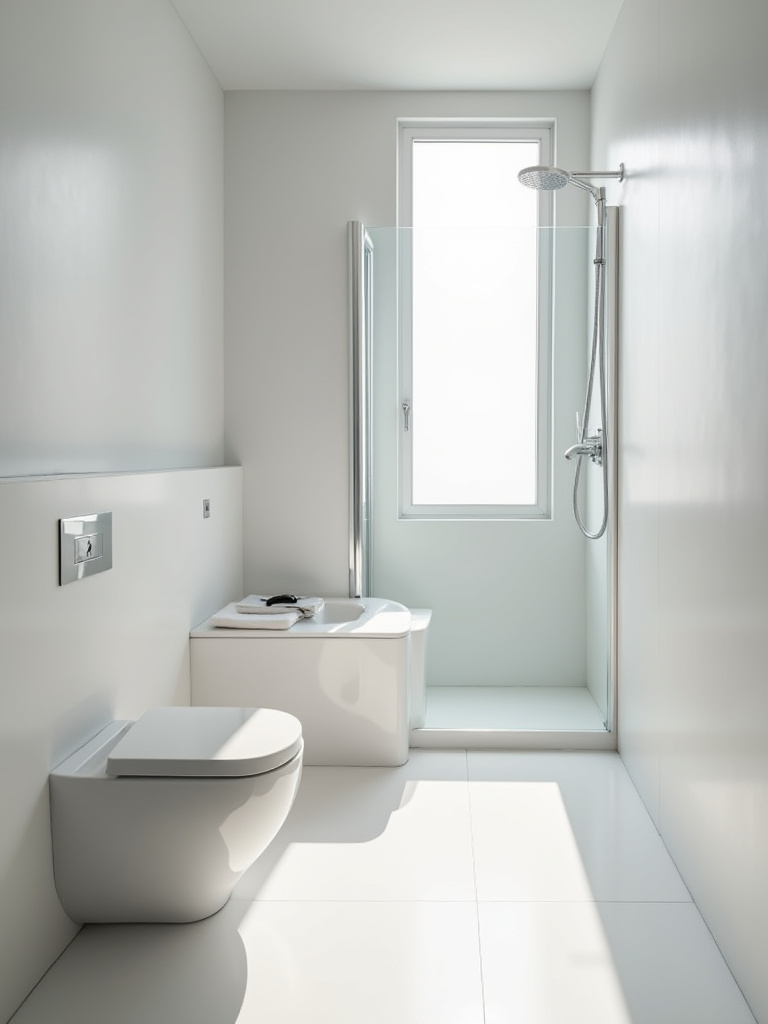
Instead of a bulky cabinet that sits on the floor, consider a floating vanity. It doesn’t “make the room bigger,” it honors the floor. It allows the space to breathe and creates a feeling of lightness. Instead of adding a shelf that juts into the room, carve a niche into the wall. You are using the quiet space within the structure. Every choice should be about creating a sense of ease and unimpeded flow, a calm path through the room.
Think of your bathroom not as a container to be filled, but as a composition of space, light, and a few essential objects.
4. Consulting with Design & Contracting Professionals
There is a profound difference between a contractor and a craftsperson. Many renovators simply see a job to be done. The right partner sees a space to be created. You are not hiring someone to install tiles; you are collaborating with someone who understands how those tiles should meet, how the grout line should feel, and how the entire composition will serve your intention.
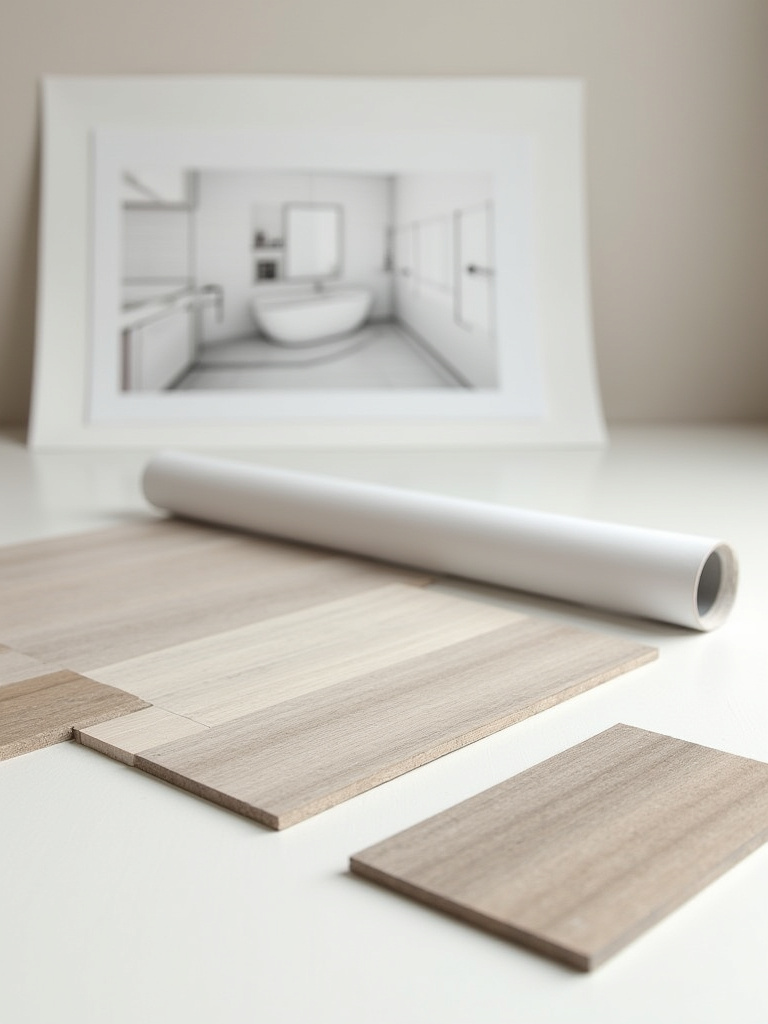
I once worked on a project where the contractor was a true artist. He would hold a piece of wood, feel its grain, and know exactly where it wanted to live in the space. He wasn’t just following a plan; he was in dialogue with the materials. Find people like this. Ask them why they do what they do. A good designer will help translate your feeling into a plan. A great craftsperson will bring that plan to life with respect and skill.
This relationship is the foundation of your renovation; choose your partners with as much care as you choose your stone.
Laying the Groundwork: Essential Planning for Your Modern Oasis (Part 2)
With our intention set and our partners chosen, we attend to the unseen structures that support our work. These steps are quiet but essential, ensuring harmony not just within the room, but with the house and the world around it.
5. Understanding Permits & Building Codes for Renovations
Many see permits as a frustrating delay. Red tape. I see it as an act of respect. You are making a change to a home that has a history and a structure. These codes and permits ensure that your change is safe, that it honors the integrity of the building, and that it is done correctly. It is a dialogue with the standards of safety and craftsmanship that protect everyone.
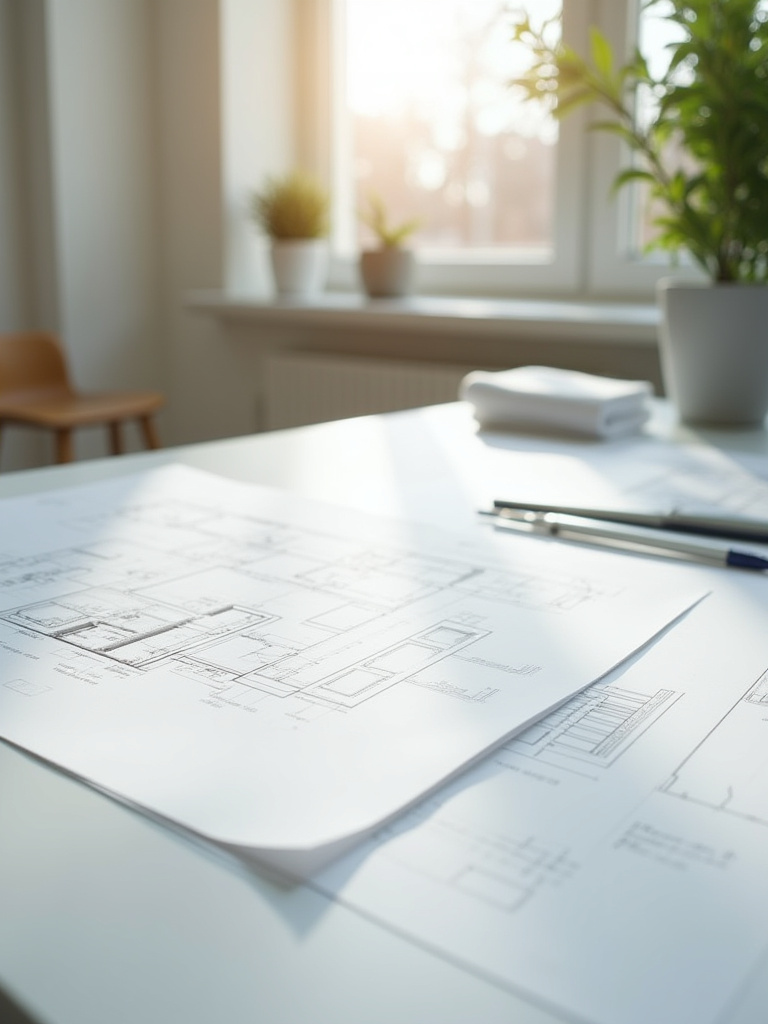
Do not try to avoid this step. To do so is to build on a foundation of dishonesty, and that feeling will permeate the space. Handle it with calm patience. A professional who understands this process will navigate it for you. It is simply part of the rhythm of doing things the right way. Your peace of mind is worth the extra time.
Once this is complete, we can begin to map out the flow of the work itself.
6. Creating a Detailed Project Timeline to Minimize Disruption
A timeline is not a rigid cage; it is a riverbank. It provides structure and guides the flow of energy, but it must also have room to bend. The purpose of a timeline is not to rush, but to create a predictable rhythm. It ensures the electrician is not waiting for the plumber, and the tiler is not waiting for the electrician. It is a choreography of skill.
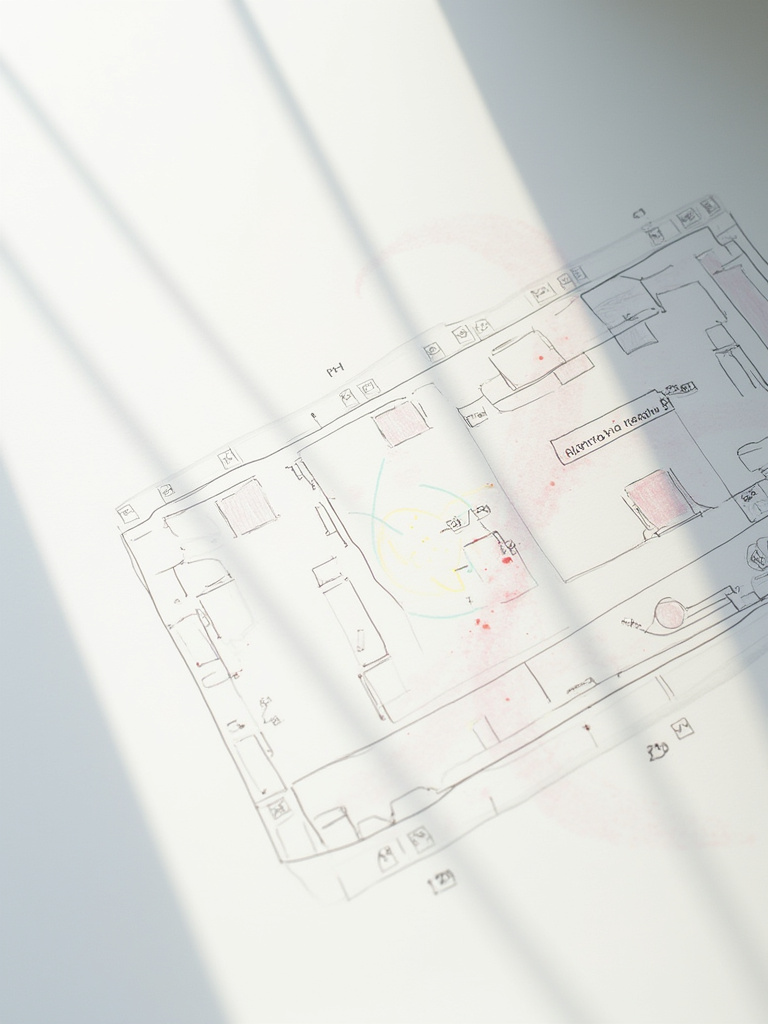
The most important part of this timeline is the space you leave between the steps. The corporate world calls this a “buffer,” but I think of it as time for the project to breathe. It is time for plaster to properly cure, for unexpected challenges to be met with calm, and for decisions to be made without haste. A rushed project is a stressed project, and that energy becomes trapped in the walls.
Let the timeline serve the project’s sense of peace, not shatter it.
Core Elements: Smart Selections & Seamless Installation (Part 1)
Now we arrive at the tangible world of objects and materials. Each choice is an opportunity to express your intention. We seek not just beauty, but a deeper harmony between form, function, and philosophy.
7. Choosing Water-Efficient & Stylish Modern Fixtures
The water that flows through your bathroom is a gift from nature. A modern fixture should honor this. People get lost in finish and shape—matte black, brushed gold—but the most elegant feature is efficiency. To use only the water you need is an act of quiet respect. It is the very definition of modern sophistication.
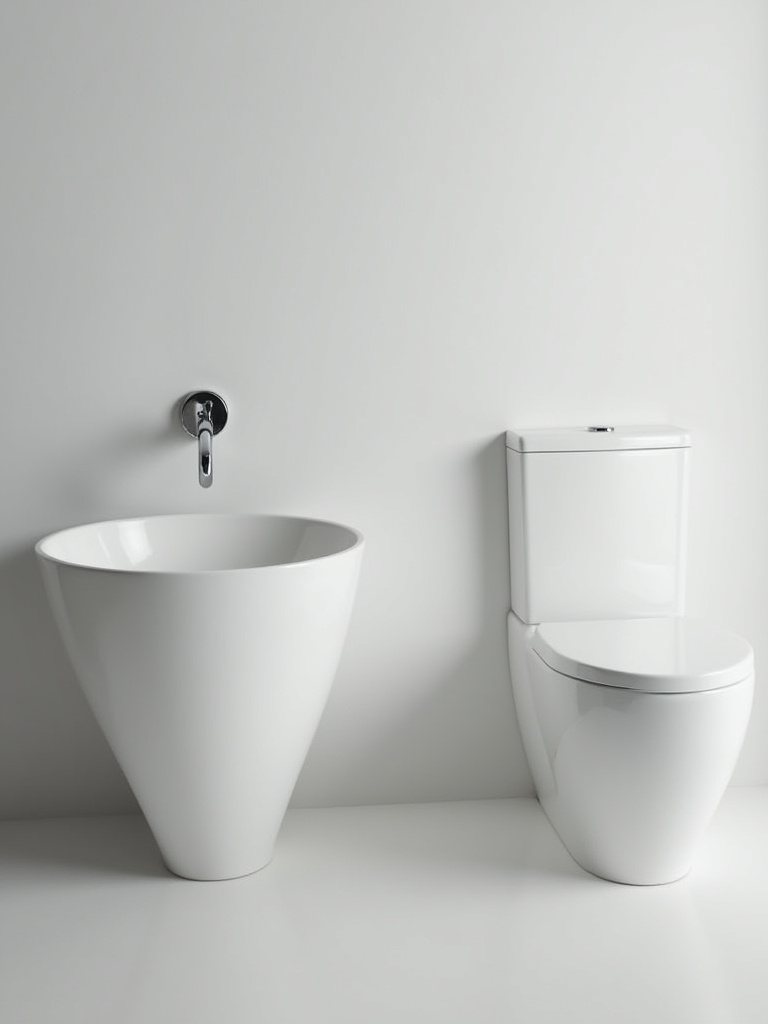
Thankfully, you no longer have to choose between beauty and responsibility. The best designers in the world create fixtures that are both breathtakingly simple and incredibly efficient. When you select a faucet, feel its weight. Note the smooth action of the handle. When you choose a showerhead, look for one that uses air to make the water feel full and soft. The goal is a luxurious experience that is also a mindful one.
This thoughtful approach extends to the very surfaces that will define your space.
8. Selecting Durable, Low-Maintenance Flooring Solutions
Your bathroom floor is the foundation of your daily ritual. It is the first thing your feet touch in the morning. It should feel grounding, solid, and calm. This is why material choice is so important. But people often mistake “luxury” for high maintenance. True luxury is a surface that does not demand your constant attention.
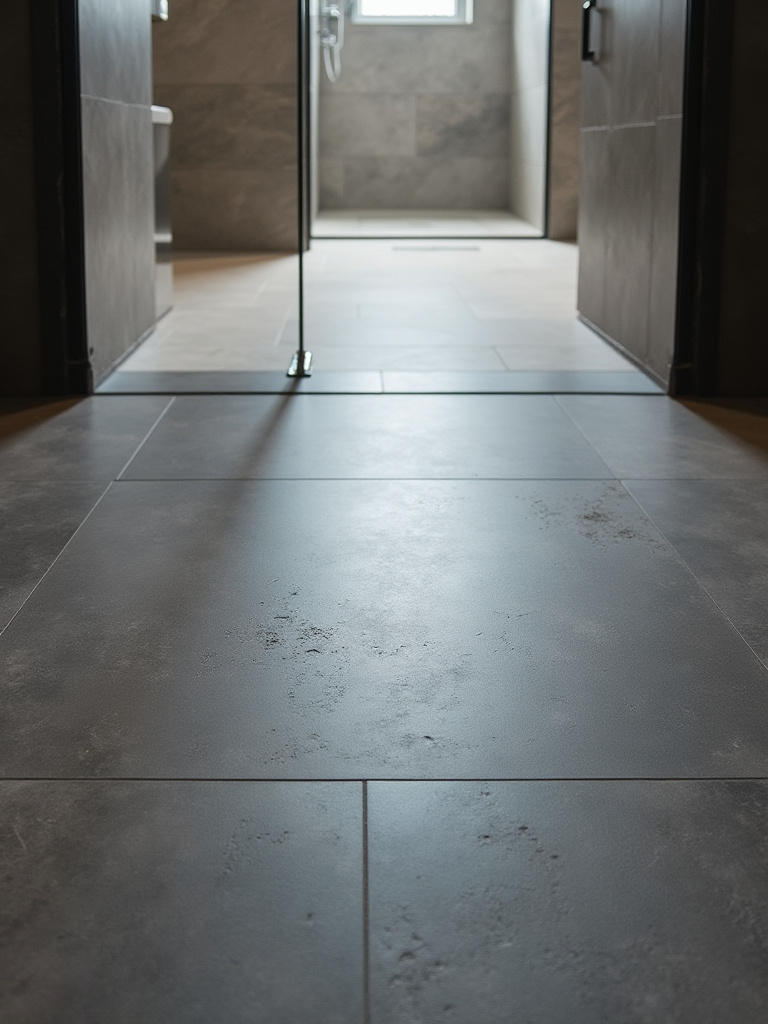
Choose a material like large-format porcelain tile. It is strong, simple, and water does not disturb it. Because the tiles are large, there are fewer grout lines—fewer visual interruptions. This creates a serene, unbroken plane that calms the eye. It is also easier to clean, which means less time spent scrubbing and more time spent simply being. Your floor should serve your peace, not steal it.
From the ground, our attention then moves to the light that fills the room.
9. Optimizing Lighting Design for Functionality & Ambiance
Light is a material. You must shape it as carefully as you shape wood or stone. The biggest mistake people make is placing a single, harsh light in the center of the ceiling. It casts shadows, flattens the space, and feels interrogating. A bathroom needs layers of light, just as a day has a morning, a noon, and a twilight.
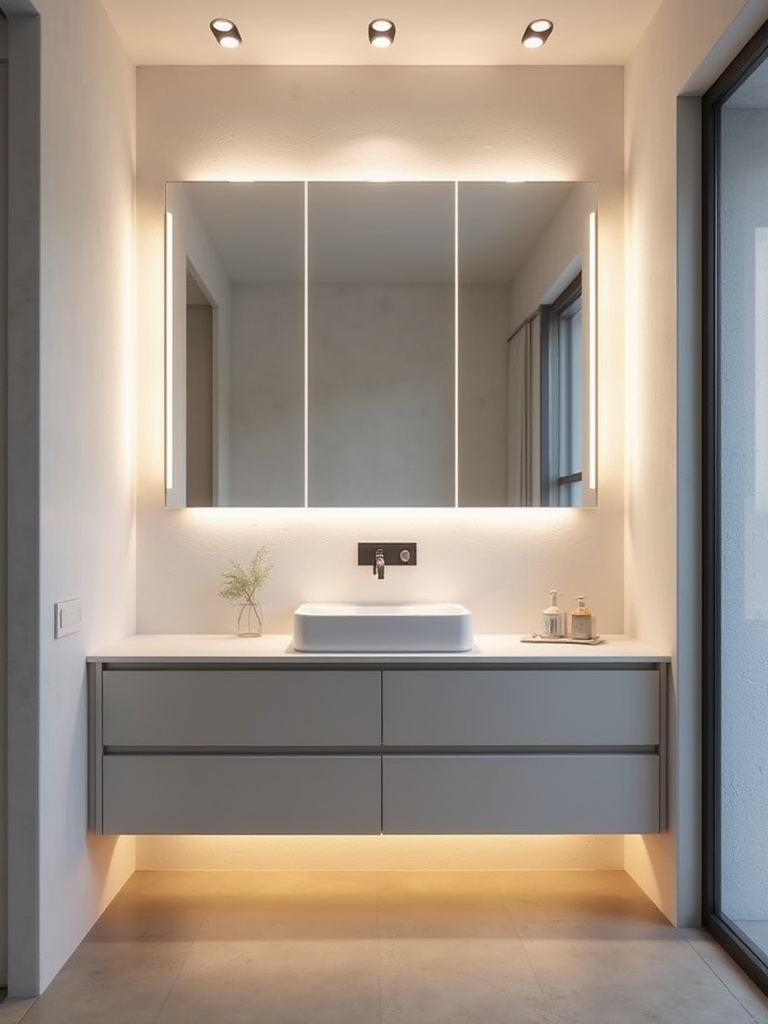
First, you need gentle, overall ambient light—a soft glow from a hidden cove or a simple ceiling fixture. Second, you need clear, honest task light at the mirror. Place lights on either side of the mirror, at eye level. This illuminates your face evenly, without shadows. Finally, consider a third, very soft accent light—perhaps under a floating vanity or inside a niche. This is the light you use for a quiet bath at the end of the day. And put it all on a dimmer. Always.
The ability to control the light is the ability to control the mood of the space.
10. Mastering Storage Solutions: Floating Vanities & Recessed Niches
A calm mind requires a calm space. Clutter is the enemy of this. Bottles, tubes, and jars scattered on a countertop create visual noise that disrupts our inner peace. But the solution is not simply to hide them away in a big, heavy box. The storage must have the same grace and lightness as the rest of the room.
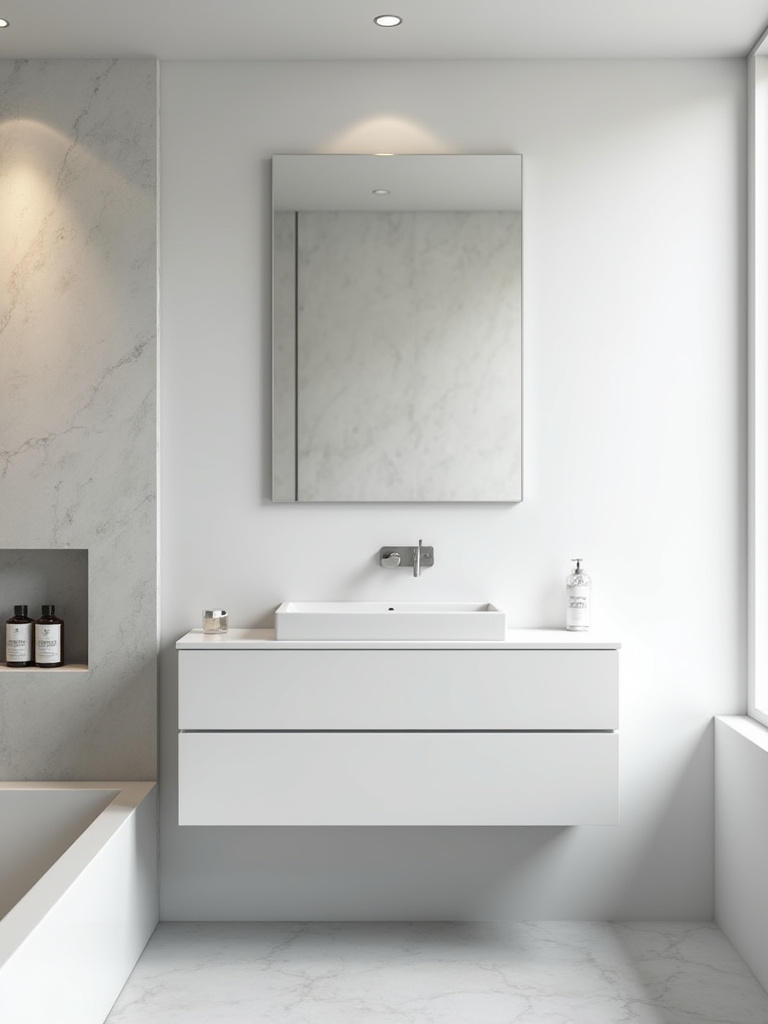
This is the beauty of a floating vanity. It provides ample storage, but by lifting it off the floor, you create a sense of spaciousness. It feels light, not heavy. And a recessed niche in the shower wall is the perfect expression of this idea. It takes no space from the room; instead, it borrows space from within the wall. It is a quiet pocket for your essentials, keeping them close but out of sight.
This is minimalism: not having less, but giving everything a quiet, considered home.
Core Elements: Smart Selections & Seamless Installation (Part 2)
We now turn our attention to the invisible systems that maintain the health and harmony of the space. Like the breath in our bodies, these elements work silently to protect and preserve, ensuring your sanctuary endures.
11. Implementing Effective Ventilation for Moisture Control
A bathroom must breathe. Without a way to exhale, the moisture from a hot shower lingers, creating a dampness that can harm the home and feel oppressive. An effective ventilation fan is the lungs of your bathroom. It is not an exciting design element, but its function is absolutely critical to the long-term health of the space.
The noise of a loud fan is disruptive, so seek out a model that is powerful yet whisper-quiet. The sound should be like a gentle sigh, not a jet engine. And it should be connected to a timer, allowing it to run for twenty minutes after you leave the room, quietly clearing the air. This simple, unseen system protects your investment and ensures the room always feels fresh and clean.
Just as important as managing the air is managing the water.
12. Ensuring Proper Waterproofing for Wet Areas
The most important work in your bathroom is the work you will never see. Behind the beautiful tile and stone, there must be a perfectly sealed, waterproof membrane. This is the hidden guardian of your home. To skip this or to do it improperly is to invite slow, silent destruction into your walls.
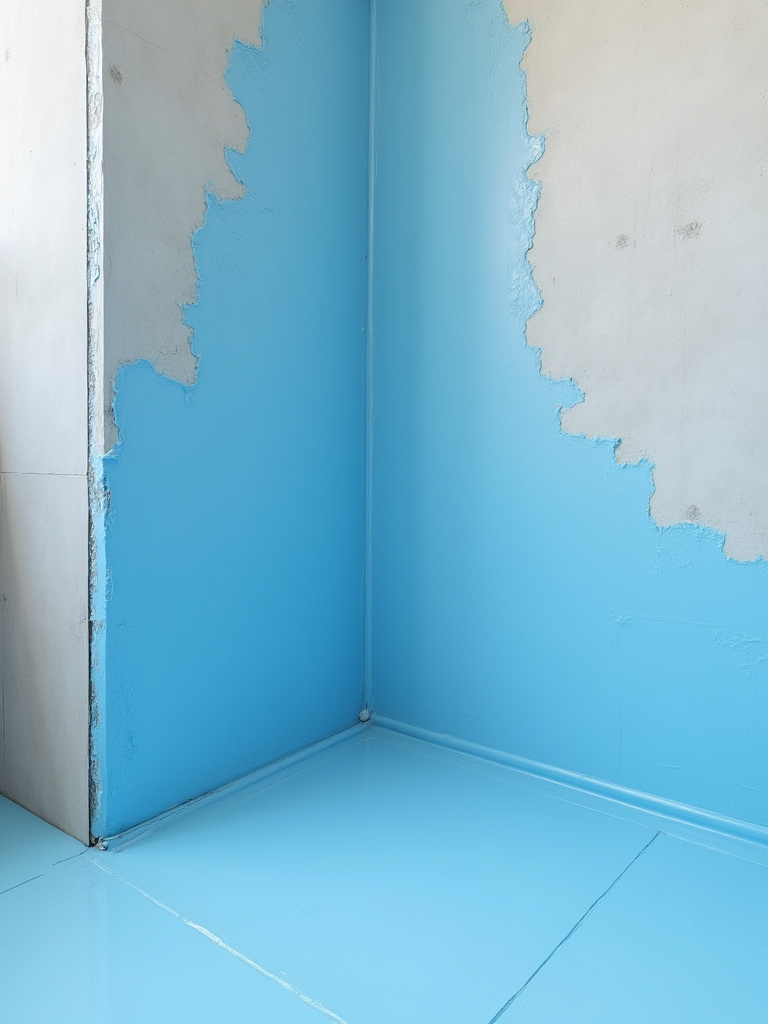
I once consulted on a renovation where, two years after completion, the homeowner noticed a small stain on the ceiling of the room below. The cost to fix the improperly waterproofed shower was five times the cost of the original installation. It is a lesson in patience and priorities. Insist that your craftsperson takes their time here. Ask to see their work before the tile is set.
This foundation of trust, built into the very walls, is what allows for true, lasting peace of mind.
Elevating the Experience: Styling, Surfaces & Sensory Details (Part 1)
With the foundation secure, we can now add the layers that engage the senses. This is where a room transforms from a well-made space into a place with soul. Every surface, every material, should be chosen for how it feels to the hand and to the eye.
13. Exploring Large-Format Tiles for a Seamless, Minimalist Look
The eye craves tranquility, and a grid of small tiles with busy grout lines is visual noise. Large-format tiles create a feeling of serene expansiveness. By reducing the number of grout lines, you create a calm, unified surface. The wall or floor becomes a single, continuous plane of color and texture.
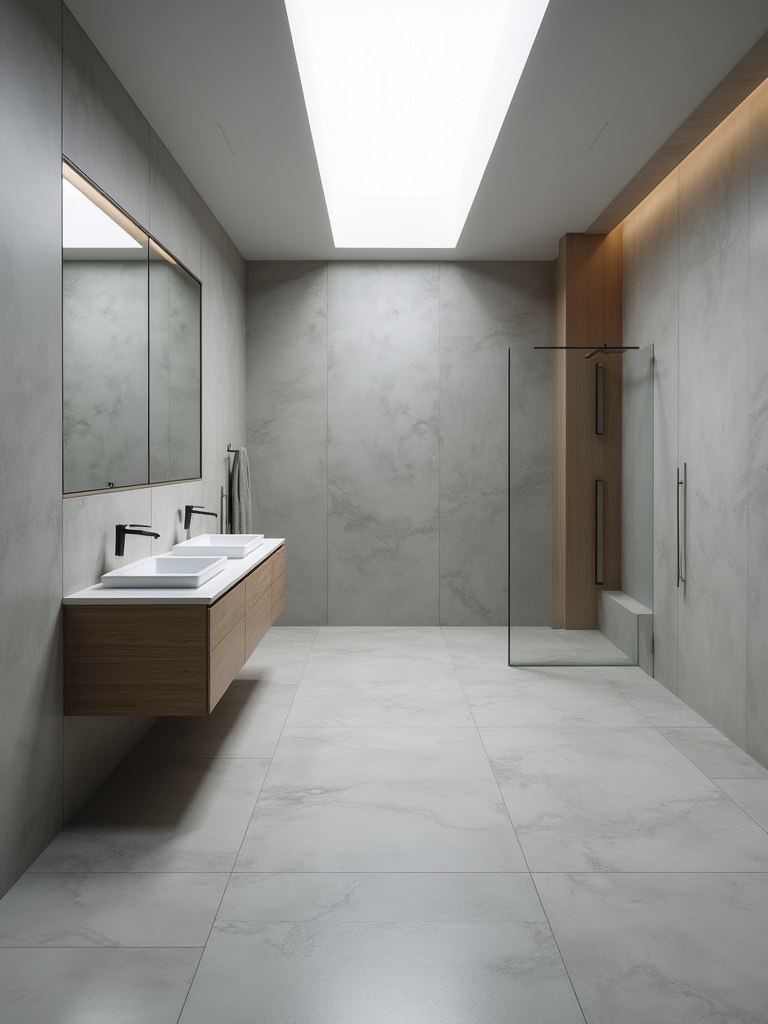
This approach is rooted in the idea of simplicity. It is not about a lack of detail, but about the right amount of detail. The subtle texture of the porcelain or the quiet veining of a stone-look tile becomes the star, uninterrupted by a web of grout. It is a modern choice that feels both luxurious and deeply calming, making even a small room feel grand and uncluttered.
This calm plane provides the perfect canvas for introducing natural textures.
14. Incorporating Natural Elements Like Wood and Stone Accents
Our souls long for a connection to the natural world. A completely sterile, man-made environment can feel cold and alienating. This is why incorporating a touch of wood or stone is so vital. It reminds us of the world outside and brings a grounding, organic warmth into a modern space.
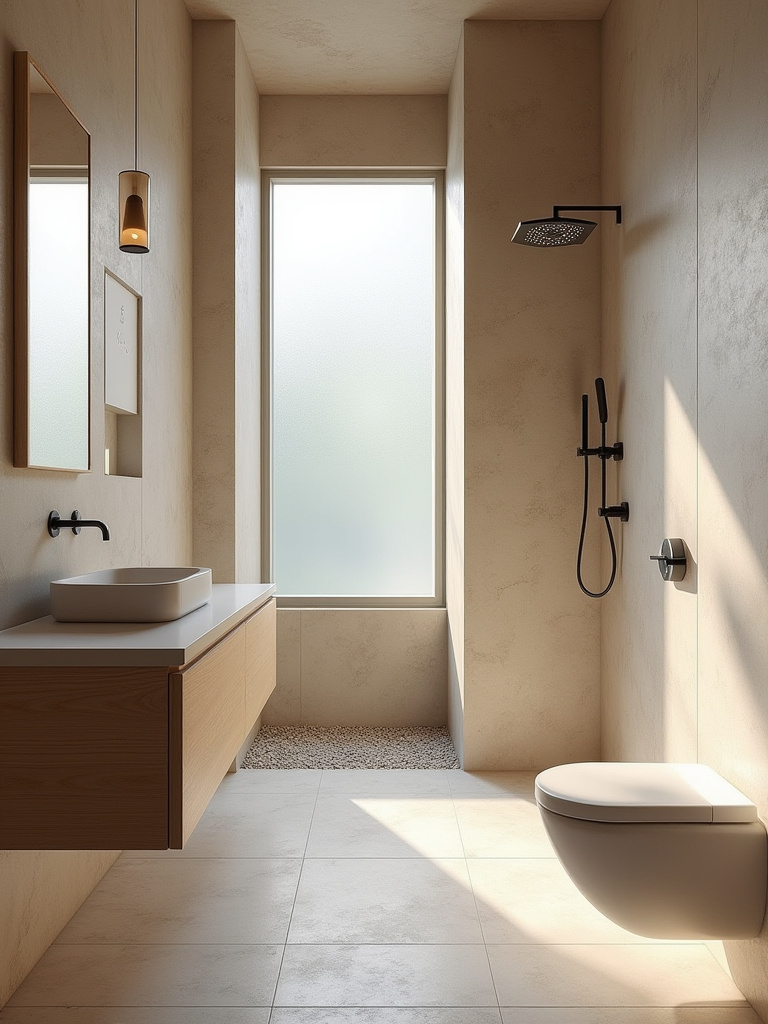
This does not need to be a grand gesture. A simple vanity made of teak or white oak, a countertop of honed marble, or even a small wooden stool next to the bath is enough. These materials have a story—the grain of the wood, the veins in the stone. They have imperfections that make them beautiful, a concept we call wabi-sabi. They connect the clean lines of modern design to the gentle, imperfect beauty of nature.
These natural elements require a thoughtful partner on the countertop.
15. Choosing Modern Countertop Materials: Quartz & Solid Surfaces
While natural stone has its soul, the countertop around the sink is a place of hard work. It must endure water, soap, and cosmetics. Here, modern engineering can offer a form of quiet perfection. Engineered quartz or solid surfaces provide a surface that is calm, consistent, and requires almost no maintenance.

These materials give you a clean, seamless surface without the worry of staining or the need for sealing. The beauty here lies in its restraint. A simple, matte white or soft gray countertop can provide a quiet visual foundation, allowing the texture of a wooden vanity or the color of a ceramic vase to take center stage. It does its job perfectly without demanding attention.
This quiet backdrop allows for a single, intentional point of emphasis.
16. Adding Strategic Pops of Color or Metallics for Visual Interest
In a quiet room, a single note of music has a powerful effect. The same is true with color or metal in a serene bathroom. We are not talking about a loud, shouting “accent wall.” Think instead of a single, deliberate gesture. The beautiful deep blue of a hand-glazed tile inside a shower niche. The warm, soft glow of brass in your faucet and towel bar.
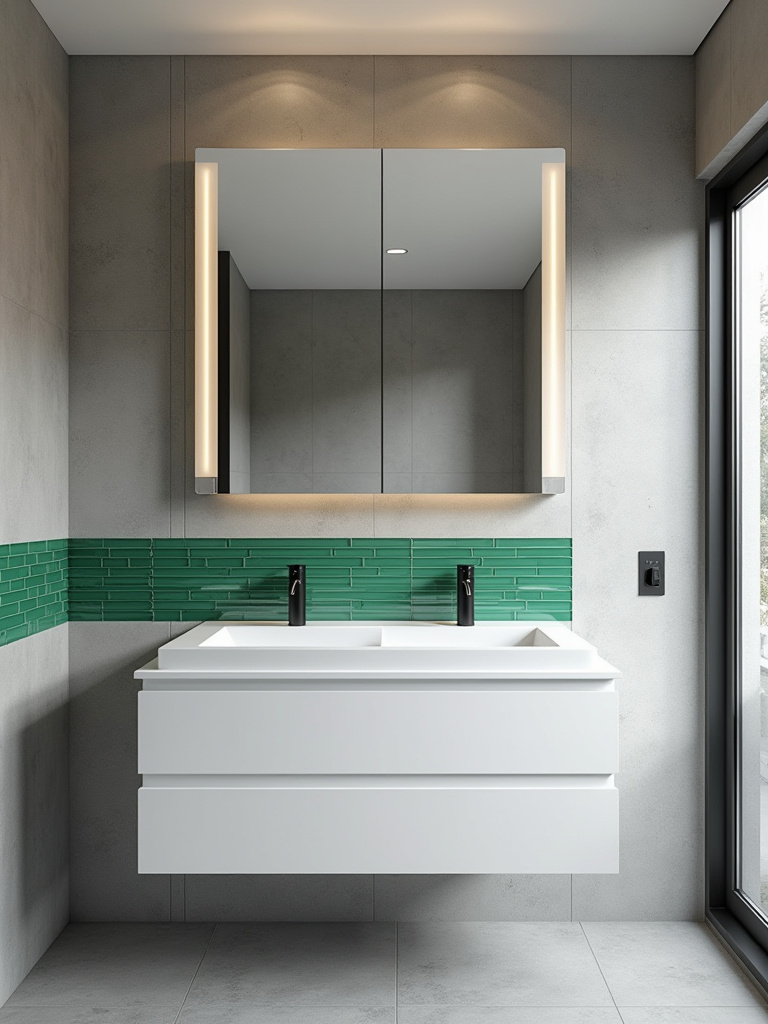
The key is restraint. In a space of whites, grays, and wood, one element of deep color or warm metal becomes a focal point. It draws the eye and provides a moment of delight. But it must be singular. Two or three competing accents create a confusing conversation. Choose one. Let it be the punctuation mark that completes the sentence of the room.
From these details of finish, we move to the forms that shape the space itself.
Elevating the Experience: Styling, Surfaces & Sensory Details (Part 2)
Here, we consider how to shape the very perception of space and sound. These elements are about removing barriers—both physical and mental—to create an environment of seamless comfort and profound tranquility.
17. Selecting Frameless Glass for Showers & Enclosures
A shower curtain or a heavy, framed door is a wall. It chops a small room into even smaller pieces. It blocks light and creates a feeling of being confined. Frameless glass, however, is not a wall. It is an absence of a wall. It is a quiet suggestion of a boundary that contains water but allows light and space to flow freely.
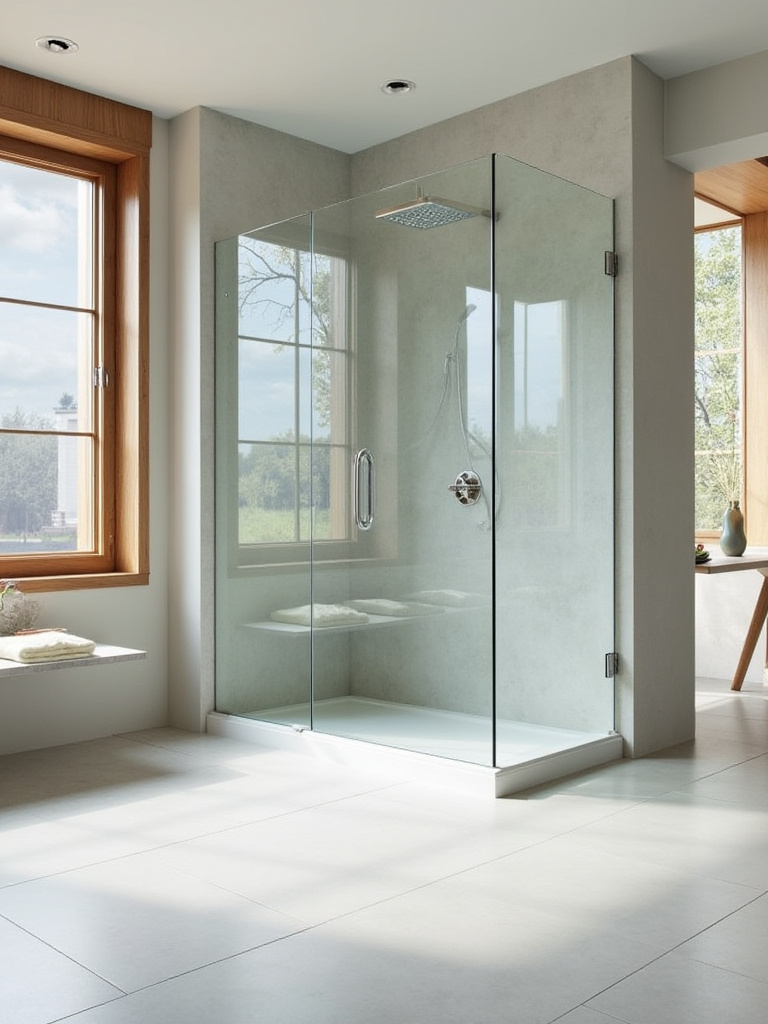
By using a single, clear plane of glass, you allow the eye to see the entire room at once. The tile in your shower becomes a continuous part of the bathroom’s design. This simple choice makes a small bathroom feel twice as large. It is the physical embodiment of the concept of ma, where the un-built space is what defines the room’s character.
Now that the visual barriers are gone, we can consider the sounds that will fill the space.
18. Integrating High-Quality Sound Systems for Relaxation
Silence is the ultimate luxury, but carefully chosen sound can be a powerful tool for transformation. Integrating a high-quality, invisible sound system into your bathroom is not for listening to loud music. It is for creating a sonic environment. Imagine stepping into the bath while the soft sound of a bamboo forest or a gentle rain fills the room.
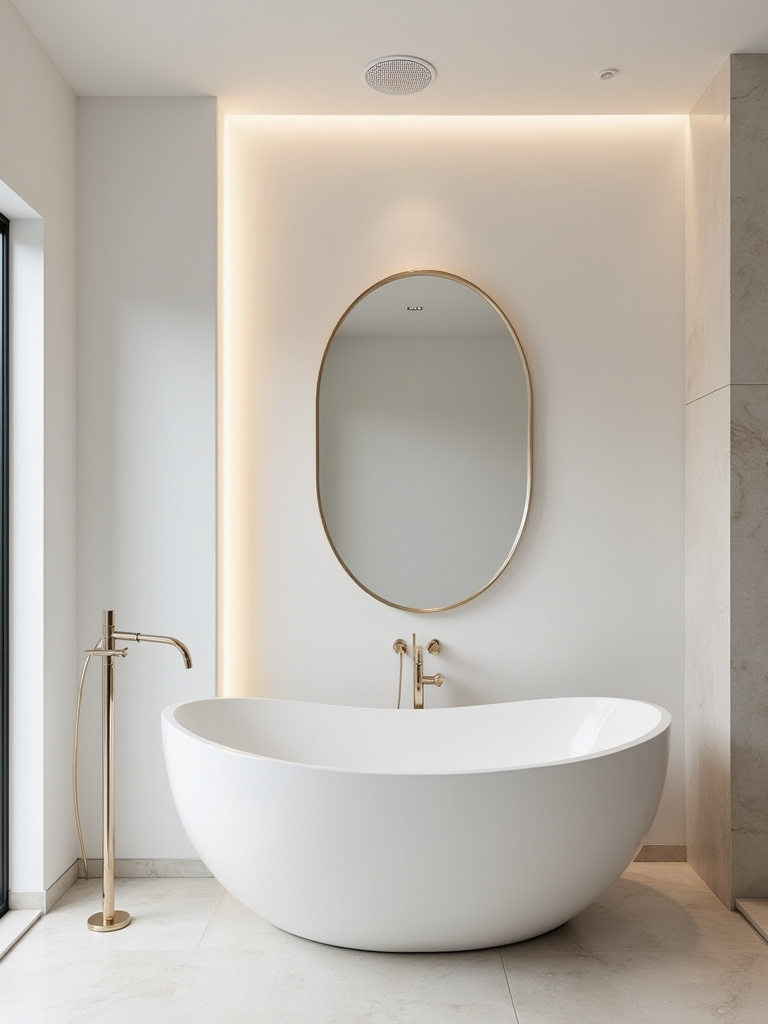
The speakers should be hidden in the ceiling, completely invisible. The sound should simply emanate from the space, with no visible source. This allows you to close your eyes and be transported. Controlled from your phone, it can provide the energizing podcast that starts your day or the guided meditation that ends it. Sound, used with intention, is a key to unlocking deeper relaxation.
These modern touches can elevate the experience in truly profound ways.
Future-Proofing & Maintenance: Advanced Innovations and Lasting Shine (Part 1)
A truly well-designed space is not just for today; it is for many years to come. This means choosing systems that offer enduring comfort and hygiene, making your sanctuary a place of effortless well-being.
19. Installing Radiant Floor Heating for Ultimate Comfort
The shock of a cold tile floor is a harsh way to start the day. It pulls you out of your warm bed into a state of alert. Radiant floor heating is the opposite. It is a gentle, silent, invisible warmth that rises from the floor to greet you. There are no noisy fans, no drafts, just a pervasive sense of comfort.
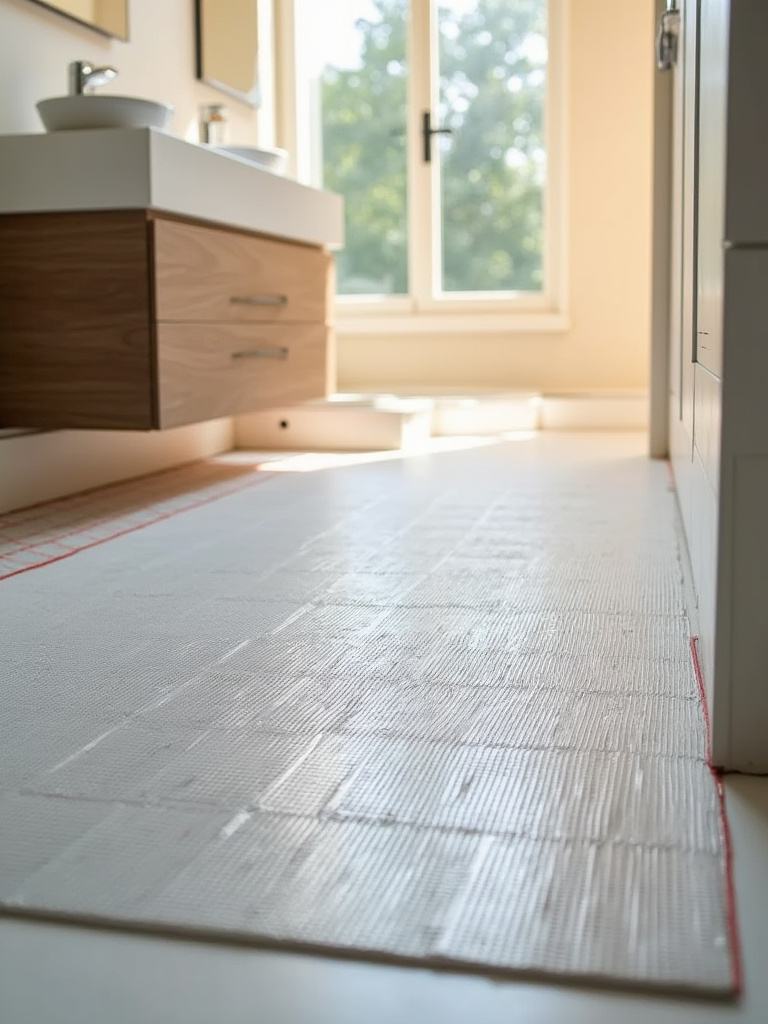
It is an incredibly efficient way to heat a space, warming the objects in the room rather than just the air. But its true value is in the feeling. To step out of the shower onto a warm floor is a small, daily luxury that has a profound effect on your sense of well-being. It is a foundation of comfort that makes the entire room feel like a gentle embrace.
This focus on subtle comfort can be paired with advancements in hygiene.
20. Exploring Touchless Faucets & Smart Toilets for Hygiene
There is a grace in technology that simplifies our daily rituals. A touchless faucet is not just about hygiene; it is about effortless motion. With a simple wave of the hand, water flows. It is a small piece of magic that reduces cleaning and adds a sense of refined ease to the simple act of washing your hands.
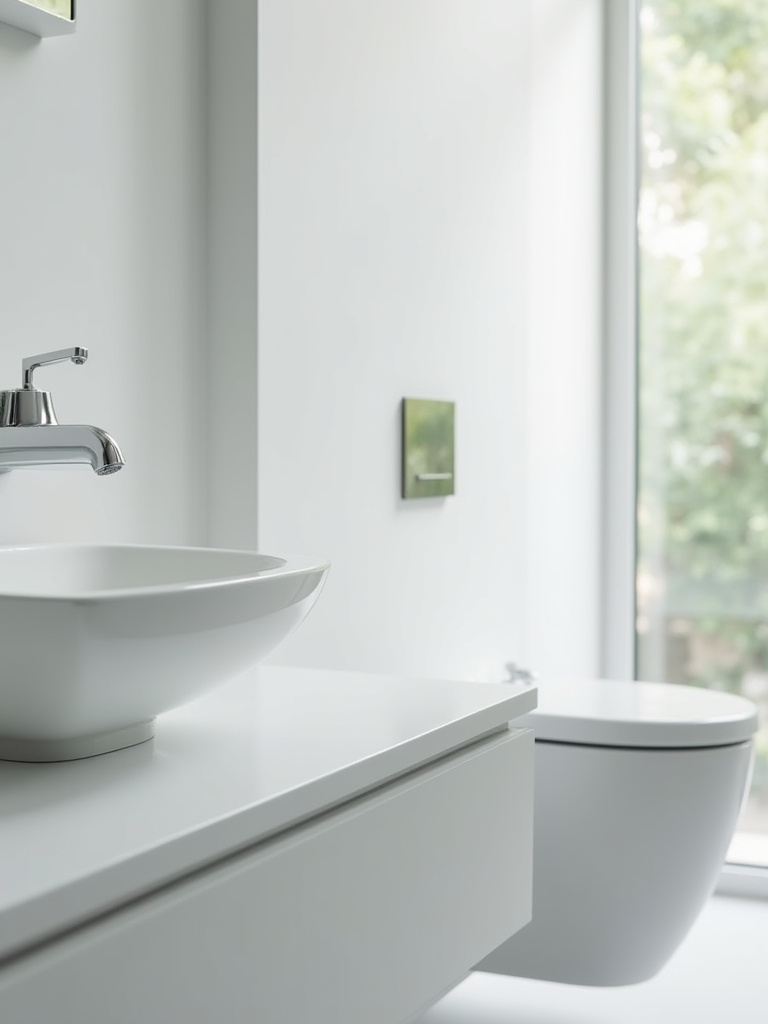
A smart toilet offers a similar elevation of a daily function. The gentle cleansing of warm water, the warmth of a heated seat on a cold morning—these are not frivolous gadgets. They are enhancements that promote a deeper sense of cleanliness and comfort. They take a purely functional object and transform it into a part of the room’s overall sense of care and well-being.
As we bring light into the space, we also seek a connection to the world outside.
21. Maximizing Natural Light with Creative Window Treatments
Natural light is the most valuable material you have. It is life-giving, energizing, and connects us to the rhythm of the day. Your goal should be to invite as much of it into your bathroom as possible, while still honoring the need for privacy. This is where creative window treatments are essential.
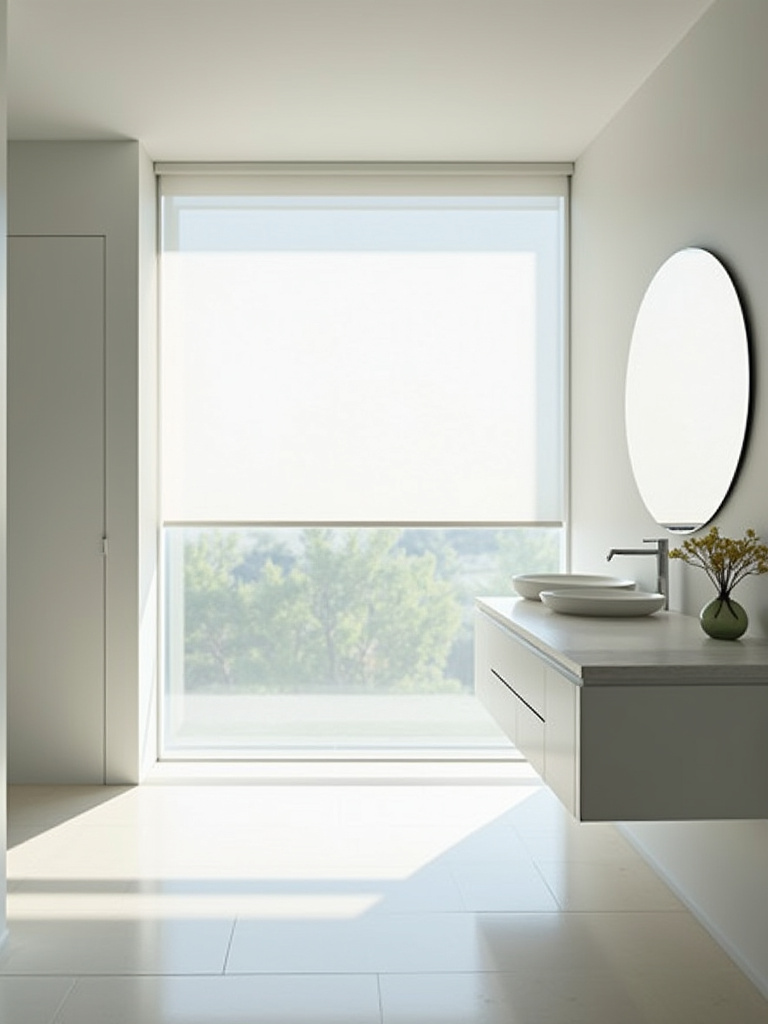
Instead of heavy blinds, consider a simple frosted film for the lower half of your window. It obscures the view while letting soft, diffused light fill the room. Or choose a top-down/bottom-up shade. This clever design allows you to lower the shade from the top, letting in light and a view of the sky while maintaining complete privacy below. Your window treatment should not be a barrier, but a filter that tunes the light perfectly for your space.
To preserve these beautiful materials, we must practice the art of gentle care.
22. Understanding Proper Sealing & Grout Maintenance Techniques
The quiet act of maintaining your space is a form of meditation. It is an expression of gratitude for the materials that create your sanctuary. Grout and natural stone are porous; they will absorb water and stains if left unprotected. The ritual of sealing them is a promise to care for your home.
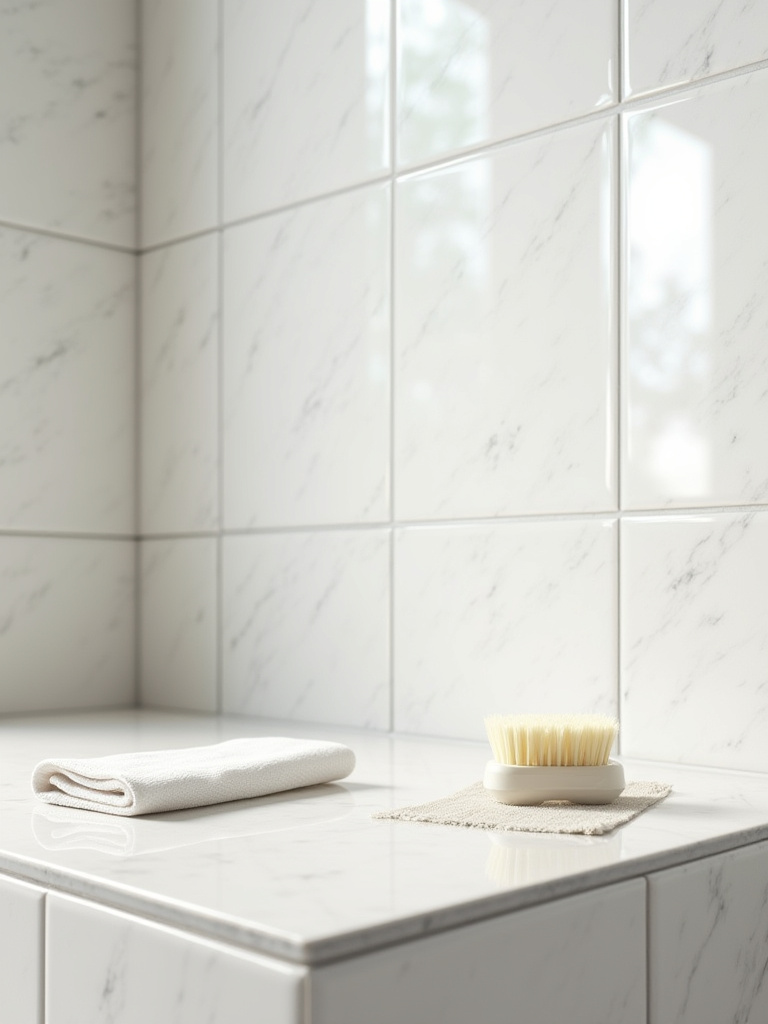
This does not require harsh chemicals. Once properly sealed, grout can be cleaned with simple, gentle solutions. The act of re-sealing every few years is not a chore; it is a moment to reconnect with your space, to notice the small details, and to ensure its longevity. A well-cared-for space reflects a well-cared-for mind.
Finally, we look beyond ourselves to a time we cannot yet see.
Future-Proofing & Maintenance: Advanced Innovations and Lasting Shine (Part 2)
Our final contemplation is perhaps the most important. It is about designing with wisdom and compassion, creating a space that can adapt and serve us through all the seasons of our lives.
23. Planning for Accessibility and Future-Proofing Considerations
The most beautiful design is one that is inclusive. Future-proofing your bathroom is not about preparing for infirmity; it is about designing a space that is effortlessly usable for everyone, at every stage of life. A child, a guest with a temporary injury, your future self—a well-designed space serves them all with grace.
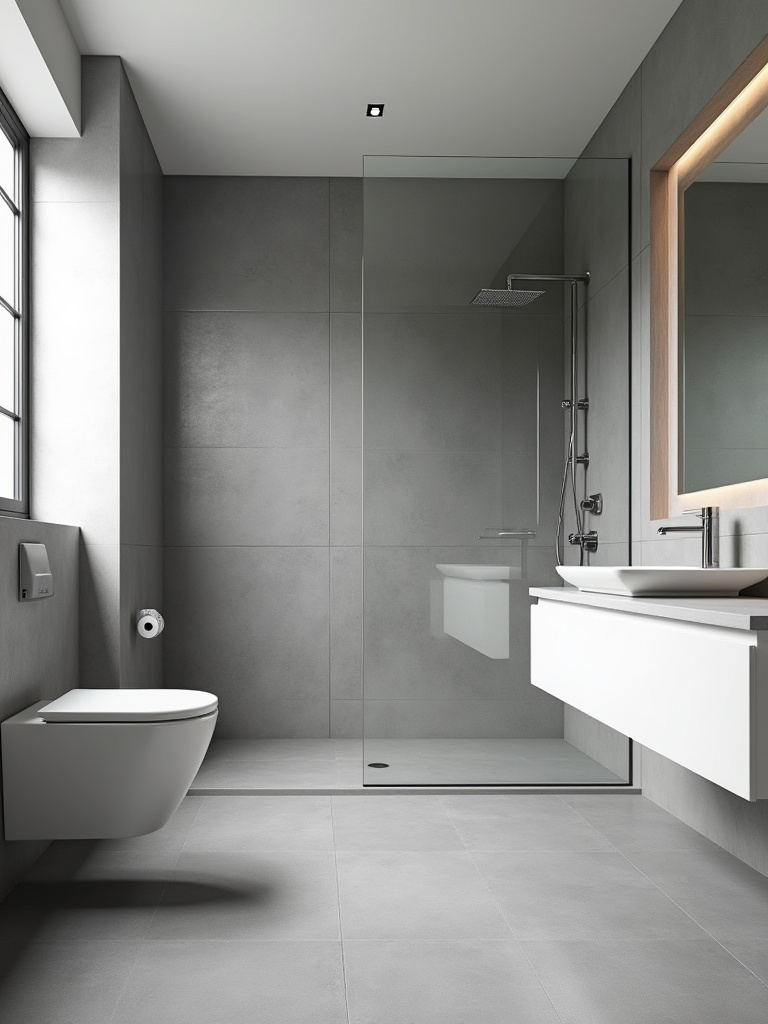
This can be done with near invisibility. A curbless shower is not only accessible, but it also creates a beautiful, seamless look. Placing wood blocking in the walls now for future grab bars costs almost nothing, but makes adding them later simple and secure, without destroying your beautiful tile. A floating vanity can be mounted at a height that allows for a wheelchair. These are not compromises; they are signs of intelligent, compassionate design.
By thinking of the future, you are creating a home that will not just shelter you, but will adapt and care for you for decades to come.
Conclusion
You see, a modern bathroom renovation is not a shopping trip. It is a process of deep inquiry. You are not just building a room; you are creating a vessel for a specific kind of feeling—of peace, of renewal, of quiet joy. Each of these 23 contemplations is a step on that path.
Don’t be swayed by fleeting trends or the pressure to have the latest thing. Start with your intention. Let every choice—from the layout to the light to the faucet handle—be an expression of that intention. The result will be more than a beautiful bathroom. It will be a sanctuary. A space that serves not just your body, but your spirit, day after day.
